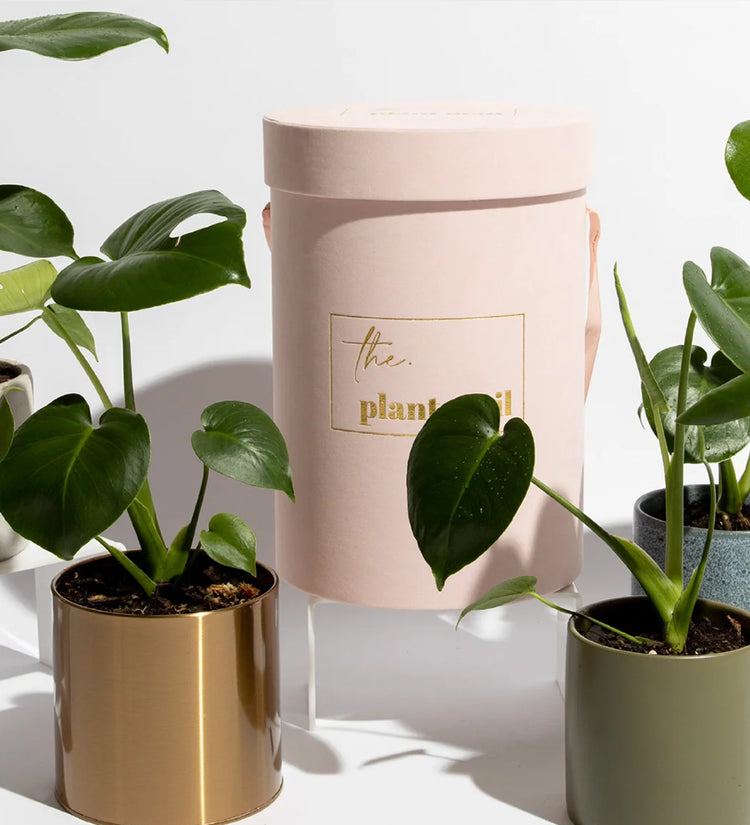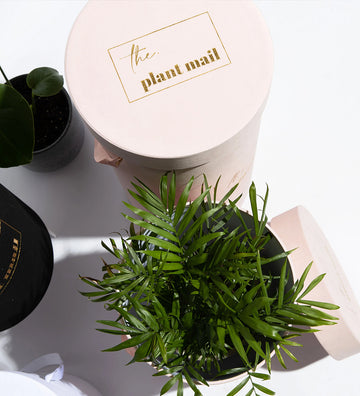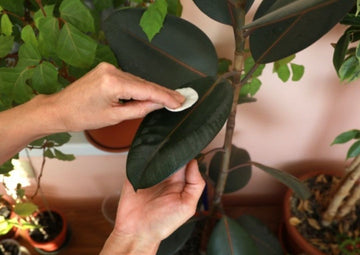
Keeping it green.
Add a touch of green to your space with our trendy and hassle-free plants, but remember: nature has a mind of its own. Don't let unexpected environmental factors cramp your plant's style and happiness.

Give your indoor plants a long and happy life with our easy care instructions.
Water Seasonally
We recommend watering weekly (we call it Water Wednesday) in warmer months and fortnightly in cooler months to avoid brown leaves and leaf-fall.
Be Light Aware
Most indoor plants prefer filtered light near a window, but avoid direct midday sun. Too much light can cause leaf burn, spotting or sudden leaf-fall, while too little light can cause your plant to wither.
Repot or Top-up
We recommend repotting every spring or summer. If they seem happy in their current pot, top them up with fresh soil instead. Beware drooping leaves, slow growth and firm soil, as they may need a new home.

Remove Dust
Houseplants collect dust over time, which can block a leaf's pores. When you notice dust, clean the leaves gently with a damp cloth.
Maintain Moisture
Stick your fingers about 3cm deep into the soil, and if it feels dry, your plant needs a healthy top-up of water.
Provide Space
Keep your plant about 2 meters away from any heating or cooling devices to avoid drying it out. During winter months, misting your plant will help keep its leaves fresh and maintain moisture in the air.
Remember, a happy plant means a happy home!
Care Instructions by Plant
Boston Fern
Boston Ferns love humidity and are therefore great for bathrooms.
Water your plant in small amounts regularly, and do not allow the soil to dry out (keeping the soil moist but not soggy). Test the soil with a bare finger and if it feels dry water it. The Boston Fern prefers a warm, well-lit spot away from direct sunlight.
Remove old fronds to keep plants looking fresh and tidy, re-fertilising in Spring and Autumn.
Devils Ivy
Water your Devils Ivy sparingly and allow the soil to dry out between watering. If you place your finger about 3cm deep into the soil and it is dry, it is likely you need to water again. Devils Ivy prefers bright filtered light out of direct sunlight, however it will adapt to lower light conditions.
Fertilise in Spring and Autumn.
Fiddle Leaf Figs
Water your Fiddle Leaf Fig sparingly and allow the soil to dry out between watering. If you place your finger about 3cm deep into the soil and it is dry, it is likely you need to water again. The Fiddle Leaf Fig prefers indirect light with small amounts of direct light. Place next to a window that gets 3-4 hours of direct light per day, and indirect light for the rest of the time.
Wipe leaves with a damp cloth to keep them healthy and looking good. Don’t forget to rotate your pot a quarter turn each month to ensure it thrives.
Fertilise in Spring and Autumn.
Parlour Palm
Water your Parlour Palm sparingly and allow the soil to dry out between watering. If you place your finger about 3cm deep into the soil and it is dry, it is likely you need to water again. Under watering is better than overwatering this beautiful plant!
The Parlour Palm prefers low light, and may actually suffer in direct sunlight, so there's no need to place it in your brightest window. They do enjoy some light so they will do best by a window that receives some early morning or late afternoon sun.
Fertilise in Spring and Autumn.
Rubber Plant
Water your Rubber Plant sparingly and allow the soil to dry out between watering. If you place your finger about 3cm deep into the soil and it is dry, it is likely you need to water again.
The Rubber Plant will enjoy being placed near a window with bright filtered light away from draughts, but it can adapt to low light.
Fertilise in Spring and Autumn.
Swiss Cheese Plant
Water your Swiss Cheese Plant sparingly and allow the soil to dry out between watering. If you place your finger about 3cm deep into the soil and it is dry, it is likely you need to water again.
This plant prefers bright filtered light out of direct sunlight. As the Swiss Cheese Plant is a climber you can add a coir or moss pole in the middle of the pot. The idea is to keep the pole moist as this plant loves the high humidity that you’d expect in a tropical rainforest.
Fertilise in Spring and Autumn.
Ficus Lyrata Bambino
Water your Ficus Lyrata Bambino sparingly and allow the soil to dry out between watering. If you place your finger about 3cm deep into the soil and it is dry, it is likely you need to water again.
This plant grows best indoors, in a well-lit position that gets filtered morning sun. Don’t forget to rotate your pot a quarter turn each month to ensure it thrives. Wipe leaves with a damp cloth to keep them healthy and looking fabulous.
Fertilise in Spring and Autumn.
Philodendron Neon
If you place your finger about 2cm deep into the soil of your Philodendron Neon and it is dry, it will need watering. This plant thrives in bright filtered light out of direct sunlight.
Fertilise in Spring and Autumn.
Peace Lily
If you place your finger about 2-3cm deep into the soil of your Peace Lily and it is dry, it will need watering. This plant thrives in medium indirect light out of direct sunlight.
Fertilise in Spring and Autumn
